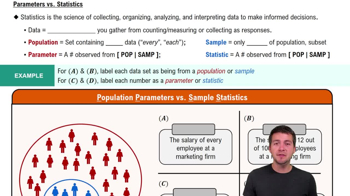c. Shown below is an interaction graph constructed from the data in Exercise 1. What does the graph suggest?
Table of contents
- 1. Intro to Stats and Collecting Data1h 14m
- 2. Describing Data with Tables and Graphs1h 55m
- 3. Describing Data Numerically2h 5m
- 4. Probability2h 16m
- 5. Binomial Distribution & Discrete Random Variables3h 6m
- 6. Normal Distribution and Continuous Random Variables2h 11m
- 7. Sampling Distributions & Confidence Intervals: Mean3h 23m
- Sampling Distribution of the Sample Mean and Central Limit Theorem19m
- Distribution of Sample Mean - Excel23m
- Introduction to Confidence Intervals15m
- Confidence Intervals for Population Mean1h 18m
- Determining the Minimum Sample Size Required12m
- Finding Probabilities and T Critical Values - Excel28m
- Confidence Intervals for Population Means - Excel25m
- 8. Sampling Distributions & Confidence Intervals: Proportion1h 12m
- 9. Hypothesis Testing for One Sample3h 29m
- 10. Hypothesis Testing for Two Samples4h 50m
- Two Proportions1h 13m
- Two Proportions Hypothesis Test - Excel28m
- Two Means - Unknown, Unequal Variance1h 3m
- Two Means - Unknown Variances Hypothesis Test - Excel12m
- Two Means - Unknown, Equal Variance15m
- Two Means - Unknown, Equal Variances Hypothesis Test - Excel9m
- Two Means - Known Variance12m
- Two Means - Sigma Known Hypothesis Test - Excel21m
- Two Means - Matched Pairs (Dependent Samples)42m
- Matched Pairs Hypothesis Test - Excel12m
- 11. Correlation1h 6m
- 12. Regression1h 50m
- 13. Chi-Square Tests & Goodness of Fit1h 57m
- 14. ANOVA1h 57m
9. Hypothesis Testing for One Sample
Steps in Hypothesis Testing
Problem 12.2.9
Textbook Question
Sitting Heights The sitting height of a person is the vertical distance between the sitting surface and the top of the head. The following table lists sitting heights (mm) of randomly selected U.S. Army personnel collected as part of the ANSUR II study. Using the data with a 0.05 significance level, what do you conclude? Are the results as you would expect?

 Verified step by step guidance
Verified step by step guidance1
Step 1: Organize the data into two groups based on handedness (Right-Handed and Left-Handed) and gender (Female and Male). Calculate the mean sitting height for each group to summarize the data.
Step 2: Perform a hypothesis test to determine if there is a significant difference in sitting heights between Right-Handed and Left-Handed individuals. Set up the null hypothesis (H₀: There is no difference in sitting heights) and the alternative hypothesis (H₁: There is a difference in sitting heights).
Step 3: Choose an appropriate statistical test, such as a two-sample t-test, to compare the means of the two groups. Ensure assumptions like normality and equal variances are checked before proceeding.
Step 4: Calculate the test statistic and p-value using the data provided. Use the significance level of 0.05 to determine whether to reject or fail to reject the null hypothesis.
Step 5: Interpret the results of the hypothesis test. If the p-value is less than 0.05, conclude that there is a significant difference in sitting heights between the groups. Discuss whether the results align with expectations based on the context of the study.
 Verified video answer for a similar problem:
Verified video answer for a similar problem:This video solution was recommended by our tutors as helpful for the problem above
Video duration:
3mPlay a video:
Was this helpful?
Key Concepts
Here are the essential concepts you must grasp in order to answer the question correctly.
Sitting Height Measurement
Sitting height is defined as the vertical distance from the sitting surface to the top of the head. It is an important anthropometric measurement used in various fields, including ergonomics and health assessments, to understand body proportions and design suitable environments. In this context, the sitting heights of U.S. Army personnel are analyzed to draw conclusions about differences based on gender and handedness.
Recommended video:
Guided course

Parameters vs. Statistics
Statistical Significance
Statistical significance is a determination of whether the observed results in a study are likely due to chance or if they reflect a true effect. In hypothesis testing, a significance level (commonly set at 0.05) is used to decide whether to reject the null hypothesis. In this case, it will help assess whether the differences in sitting heights among groups are statistically meaningful.
Recommended video:
Guided course

Parameters vs. Statistics
Comparative Analysis
Comparative analysis involves evaluating two or more groups to identify differences or similarities in their characteristics. In this scenario, the sitting heights of right-handed and left-handed individuals across genders are compared. This analysis can reveal insights into how factors like gender and handedness may influence physical measurements, contributing to broader understanding in anthropometry.
Recommended video:
Guided course

Comparing Mean vs. Median

 6:21m
6:21mWatch next
Master Step 1: Write Hypotheses with a bite sized video explanation from Patrick
Start learningRelated Videos
Related Practice
Textbook Question
